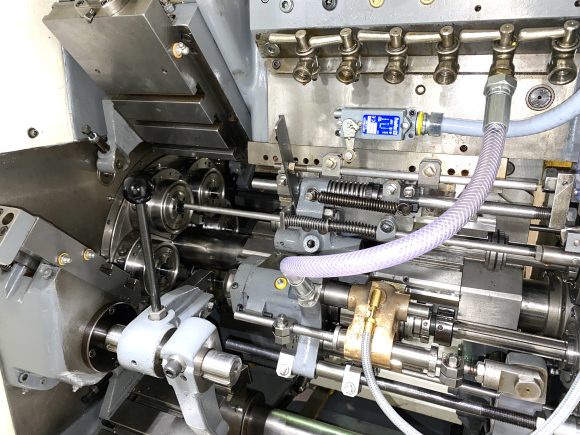For years, Graff-Pinkert has tried to convince customers who use 6-spindle Acme-Gridley or New Britain automatic screw machines that they would benefit from running Wickmans instead.
Before I go any further with this spiel, I want to add that I have never run production, so I’m sure there are reasons why Wickmans are not always the best option. And, the point of this blog is a lot more than just a commentary on screw machines.
That said, Wickmans have a lot of advantages over other multi-spindles, such as not requiring changing cams, and their stems don’t have a bronze bushing that wears over time. It’s also easier to change attachments on a Wickman because you don’t have to rebore the machine. Those are just a few of the logical reasons to switch to Wickmans, but Acme and New Britain users still usually don’t want to change—even when we make what we believe is a compelling pitch to do so.
Companies don’t want to buy new spare parts and tooling for Wickmans because they already have so much on the shelf. They have employees who are experts with their current machines, who have been running them for decades. Customers are also probably thinking the time spent learning to use a new type of machine will get in the way of making parts they need right away, which are probably already high quality.
It’s easy for me to get frustrated by this attitude, but then I look at myself. Our website for Graff-Pinkert is on its last legs. The platform it was built on will be obsolete by the end of the year, and then we will have to switch to something new, which I know will be better than what we currently have. But I will wait until I’m forced to change because change can be uncomfortable, tedious, and sometimes truly painful.
For the majority of people, the only thing that will get them to make a change and improve what they are currently doing is when the pain caused by staying the same becomes greater than the pain of making a change.
It’s similar to leaving a mediocre romantic relationship. A great deal of people will only end it when it becomes unbearable enough that they have no choice.
My observation is that the world’s most successful people are the ones willing to get out of their comfort zone and face new pain head on before they are forced to. They keep improving how they do things, while most of us settle for the status quo as long it’s “good enough.”
For a while now, I’ve made it a personal mission to step out of my comfort zone often and improve proactively. I want to be comfortable being uncomfortable—and not just when it suits me. Unfortunately, I think a trap I fall into is choosing to overcome the “easier” uncomfortable things, rather than the most painful stuff.
I know I need to seize my pain, not wait for it to seize me.
Questions: What changes have you made in your life or business recently?
What changes do you intend to make?


4 Comments
Perhaps choices are made on the basis of how much work is involved. Learning a new tool requires an investment of work. Maybe work is too big of a pain. Might explain the shortage of workers.
Thanks for commenting Pat!
Work is a pain. It’s all about picking the pain that is less bad.
Good commentary Lloyd. On the Wickman thing, those advantages are real. Having worked with several screw machine makes, I would add that Wickman came after Warner & Swasey, which has many of the same attributes. Many folks don’t know that Warner & Swasey also made telescopes; one of their larger models over 20″ diameter is in use to this day in the countryside 30 miles east of Cleveland.
Thanks for the compliment Joe!
Wickmans are a great design. So why have we sold 10x more Davenports in the last 2 years?
Btw, I wrote this one. 🙂 Not my dad.